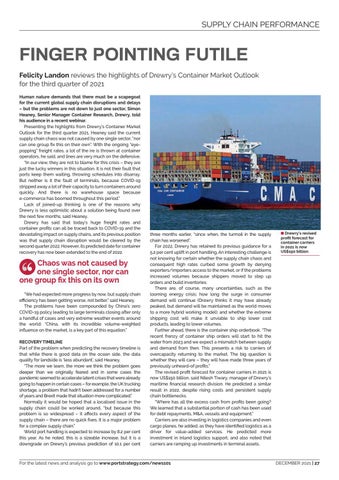SUPPLY CHAIN PERFORMANCE
FINGER POINTING FUTILE Felicity Landon reviews the highlights of Drewry’s Container Market Outlook for the third quarter of 2021 Human nature demands that there must be a scapegoat for the current global supply chain disruptions and delays – but the problems are not down to just one sector, Simon Heaney, Senior Manager Container Research, Drewry, told his audience in a recent webinar. Presenting the highlights from Drewry’s Container Market Outlook for the third quarter 2021, Heaney said the current supply chain chaos was not caused by one single sector, “nor can one group fix this on their own”. With the ongoing “eyepopping” freight rates, a lot of the ire is thrown at container operators, he said, and lines are very much on the defensive. “In our view, they are not to blame for this crisis – they are just the lucky winners in this situation. It is not their fault that ports keep them waiting, throwing schedules into disarray. But neither is it the fault of terminals, because COVID-19 stripped away a lot of their capacity to turn containers around quickly. And there is no warehouse space because e-commerce has boomed throughout this period.” Lack of joined-up thinking is one of the reasons why Drewry is less optimistic about a solution being found over the next few months, said Heaney. Drewry has said that today’s huge freight rates and container profits can all be traced back to COVID-19 and the devastating impact on supply chains, and its previous position was that supply chain disruption would be cleared by the second quarter 2022. However, its predicted date for container recovery has now been extended to the end of 2022.
Chaos was not caused by one single sector, nor can one group fix this on its own
‘‘
“We had expected more progress by now, but supply chain efficiency has been getting worse, not better,” said Heaney. The problems have been compounded by China’s zero COVID-19 policy leading to large terminals closing after only a handful of cases and very extreme weather events around the world: “China, with its incredible volume-weighted influence on the market, is a key part of this equation.” RECOVERY TIMELINE Part of the problem when predicting the recovery timeline is that while there is good data on the ocean side, the data quality for landside is ‘less abundant’, said Heaney. “The more we learn, the more we think the problem goes deeper than we originally feared and in some cases the pandemic seemed to accelerate latent crises that were already going to happen in certain cases – for example, the UK trucking shortage, a problem that hadn’t been addressed for a number of years and Brexit made that situation more complicated.” Normally it would be hoped that a localised issue in the supply chain could be worked around, “but because this problem is so widespread – it affects every aspect of the supply chain – there are no quick fixes. It is a major problem for a complex supply chain.” World port handling is expected to increase by 8.2 per cent this year. As he noted, this is a sizeable increase, but it is a downgrade on Drewry’s previous prediction of 10.1 per cent
three months earlier, “since when, the turmoil in the supply chain has worsened”. For 2022, Drewry has retained its previous guidance for a 5.2 per cent uplift in port handling. An interesting challenge is not knowing for certain whether the supply chain chaos and consequent high rates curbed some growth by denying exporters/importers access to the market, or if the problems increased volumes because shippers moved to step up orders and build inventories. There are, of course, many uncertainties, such as the looming energy crisis; how long the surge in consumer demand will continue (Drewry thinks it may have already peaked, but demand will be maintained as the world moves to a more hybrid working model); and whether the extreme shipping cost will make it unviable to ship lower cost products, leading to lower volumes. Further ahead, there is the container ship orderbook. “The recent frenzy of container ship orders will start to hit the water from 2023 and we expect a mismatch between supply and demand from then. This presents a risk to carriers of overcapacity returning to the market. The big question is whether they will care – they will have made three years of previously unheard-of profits.” The revised profit forecast for container carriers in 2021 is now US$150 billion, said Nilesh Tiwary, manager of Drewry’s maritime financial research division. He predicted a similar result in 2022, despite rising costs and persistent supply chain bottlenecks. “Where has all the excess cash from profits been going? We learned that a substantial portion of cash has been used for debt repayments, M&A, vessels and equipment.” Carriers are also investing in logistics companies and even cargo planes, he added, as they have identified logistics as a driver for value-added services. He predicted more investment in inland logistics support, and also noted that carriers are ramping up investments in terminal assets.
For the latest news and analysis go to www.portstrategy.com/news101
8 Drewry’s revised profit forecast for container carriers in 2021 is now US$150 billion
DECEMBER 2021 | 27














